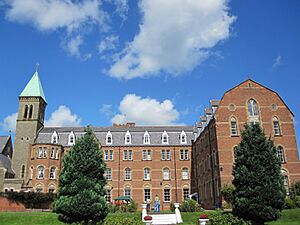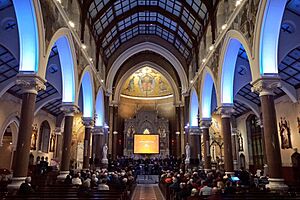Clonard Monastery facts for kids
Clonard Monastery is a special Catholic church found near the Falls Road in Belfast, Northern Ireland. It's home to a group of priests called the Redemptorists, who are part of a religious community.
Contents
A Look Back: Clonard's History
In the late 1800s, many Catholic people lived in Belfast. There were so many that the local priests found it hard to help everyone. Because of this, the Bishop of Down and Connor, Henry Henry, asked the Redemptorists to come to Belfast in 1896.
Building the Monastery
The Redemptorists first built a small church made of tin in 1897. This was on the grounds of Clonard House. A few years later, in 1890, a monastery (a home for the religious community) was opened there. It was built in an old French Gothic style. Finally, in 1911, the main Church of the Holy Redeemer opened. This new church replaced the smaller tin church.
Restoring the Church
From 2008 to 2012, Clonard Church went through a big restoration project. This work cost about £3,000,000. The project made sure the church was beautifully repaired and ready for many more years of use.
Religious Activities at Clonard
Over the years, the Clonard community has started many religious activities. These activities help people connect with their faith.
Early Groups and Gatherings
One of the first activities was setting up special groups called confraternities for men and women in 1897. These groups offered religious services and teaching. They were very popular for a long time. However, fewer people joined over the years. The women's group stopped in 2019, and the men's group closed the following year.
Special Prayers and Missions
Two other important religious activities began at Clonard. One was a "perpetual" Novena to honor Our Lady of Perpetual Succour. A novena is a special prayer that lasts for nine days. The other was a "Mission to non-Catholics." This mission helped people from different backgrounds come together. It was easier to do this because tensions between groups were lower during wartime.
Today, the Clonard community still holds its annual Novena for Our Lady of Perpetual Succour. This event attracts over 100,000 visitors. People from both Catholic and Protestant backgrounds come from all over Ireland to take part.
Clonard and The Troubles
Clonard Monastery is in an important location in Belfast. It sits between the mainly Catholic Falls Road area and the mainly Protestant Shankill Road area. This area was a "frontline" during the troubles, which started in Belfast in August 1969. Behind the monastery were streets like Bombay Street and Cupar Street, which led to the Shankill Road.
Helping During Difficult Times
On August 14, 1969, people from the Shankill Road attacked homes owned by Catholics on these streets. Many residents had to leave their homes. Many houses were burned down, including all of Bombay Street. The priests from Clonard were very active from the start. They worked hard to keep the local residents safe.
Two important religious leaders who worked for peace in Northern Ireland lived at Clonard. They were Father Alec Reid and Father Gerry Reynolds.
Clonard's Work Today
Since 1981, the Redemptorist priests at Clonard have worked with Fitzroy Presbyterian Church. This church is near Queen's University, Belfast in the south of the city. Clonard Monastery became a key place for peacemaking and helping people come together.
Peace Talks and Community Events
Important secret talks happened in rooms at the monastery. These talks were between John Hume and Gerry Adams. Wider discussions between different faiths also took place. These efforts helped lead to the IRA ceasefire in 1994. Clonard is also used as a place for music events. It hosts many festivals in the city, including Féile an Phobail.
See also
 In Spanish: Monasterio de Clonard para niños
In Spanish: Monasterio de Clonard para niños





